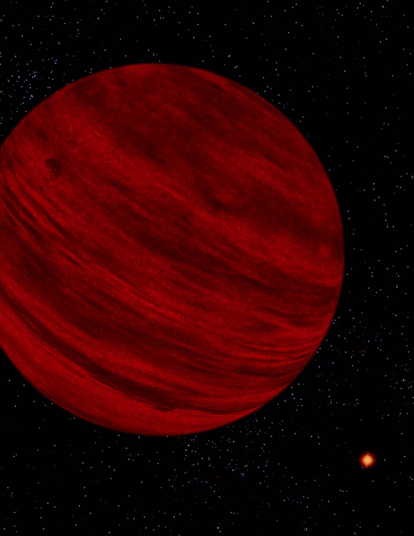Brown Dwarfs
These substellar objects were first conceived of
in the early 1960s as "failed stars". Stellar models suggested that a true star
must have a mass at least 80 times that of Jupiter to kindle the stable fusion
of hydrogen (this limit is currently thought to be about 75 jupiters). Objects
with less mass were believed to exist, but it was recognized that they would be
extremely difficult to find because they would be quite low in luminosity, and
emit very little visible light. For that reason, they can
be viewed as a constituent of baryonic "dark matter". Indeed, we currently have
a hard time directly seeing an old brown dwarf beyond 100 pc. After 20 years of
searching and false starts, the first confirmed brown dwarfs were announced in
1995. This was due to a combination of increased sensitivity, better search strategies,
and new means of distinguishing substellar from stellar objects. Since then, a
great deal of progress has been made on the observational front. We are now in
a position to say a substantial amount about actual brown dwarfs. We have a rough
idea of how many of them occur as solitary objects and how many are found in binary
systems. We have obtained the first glimpse of atmospheres intermediate in temperature
between stars and planets, in which dust formation is a crucial process. This
has led to the proposal of the first new spectral classes in several decades,
and the need for new diagnostics for classification and setting the temperature
scale. The first hints on the substellar mass function are in hand, although current
masses depend on models. It appears that numerically, brown dwarfs may be nearly
as common as stars (though they do not contain a dynamically interesting amount
of mass).

|
Caption: Artist's Impression of the brown dwarf Gl 229B (with the
low mass star Gl 229A) sitting about 40 AU away. This brown dwarf is a
few billion years old, with a surface temperature of about 1000K. Its
mass is in the 30-50 jupiter mass range (or 3-5% of our Sun). The dull
red color is what your eye would see, there is more luminosity coming
out in the near infrared. The dark bands are hypothetical; although
dust does form in the atmospheres of brown dwarfs, it is unclear how
non-uniform their appearance is. The banding is reasonable, since they
usually rotate very fast (in hours; like Jupiter). A couple of magnetic
"spots" are also shown; there is evidence of magnetic fields at least
on the younger brown dwarfs (although it doesn't give rise to the same
atmospheric heating and activity as on stars). Gl 229B is about 100,000
times fainter than our Sun (and almost 1000 times fainter than its low
mass stellar companion).
Picture Credit: Pat Rawlings (Scientific American)
[click here for fuller resolution image 63kb]
The 2013 chapter (pdf) about
"The Discovery of the First Lithium Brown Dwarf: PPl 15"
as published in the book
"50 Years of Brown Dwarfs"
V. Joergens (ed.); Springer
The final verison (pdf) of "Observations of Brown Dwarfs"
which appeared in
Annual
Reviews of Astronomy and Astrophysics
Volume 38, p. 485, 2000
The April 2000 Scientific American
article (pdf)
"The Discovery of Brown Dwarfs"
as published in a later Sci Am collection of stellar articles
Invited Plenary Lecture (.ppt) to American Astronomical Society
(Jan. 2004)
"Brown Dwarfs: Up Close and Physical"
Last updated on Jan. 26, 2004.
I would like to acknowledge the support of the National Science
Foundation through grant AST-9618439 for much of my work that is
reported on this page. Eduardo Martin has been a full collaborator in
most of it.